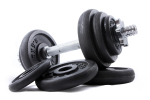- FreeTrainers.com Forums
- General Fitness & Exercise
- Serious problems building upper arms.
Group: General Fitness & Exercise
Created: 2011/12/31,
Members: 383,
Messages: 54581
Various general exercise related discussions. Find out what it takes to reach your fitness goals through daily effective exercise. With so many options we try to find out what works best.
Join group
Serious problems building upper arms.

nebomonster
Posts:
3
Joined: 2002/12/17  |
2003/05/07, 05:40 PM
Hello. I have been doing a routine for a while now, probably about 6 months, and I'm having serious problems with my arms. I am naturally slender, and have difficulty putting on any muscle at all.
I can't lift a lot of weight. I am using 35 pound dumbells for my biceps, as well as doing reverse curls (I think they're called anyway... the backwards ones where you put your thumb and fingers on top of the bar and curl it towards you) and as far as chest exercises go the only thing I can use is a low-end model Total Gym. I realize it would be a lot better to use free bench pressing, but I don't have access to that right now. When I started doing this, my biceps seemed to get bigger very quickly. They grew noticably within a month, and got a little bigger in the next month, but then my progress completely died off. I feel like they're the same size as before I started anything. I have a feeling it's my diet. I have a really hard time with the recommended amount of protein the website gives me (something like 250 grams!) and I usually eat around 170-180 a day. I weigh 155 pounds. Do I really need to eat 250+ grams a day? Also, what kind of meal substitutes could I use? I eat cottage cheese, milk, eggs, and meat, and that's about all. It's really hard to eat every few hours because none of that is very "portable." I don't want to spend a lot of money on stuff, and I don't want to use anything like Creatine. Just natural stuff, please :) Thanks in advance. |
|
| |

7707mutt
Posts:
7,686
Joined: 2002/06/18  |
2003/05/07, 05:46 PM
Ok with just waht you have given here I think that you have reached that point where you have leveld off-a plateau. This means your body is so used to the routine and weights that it is no longer challenged enough to need to add extra muscle. There are a few things you can do. One is to get more weights, go to a gym and I gather that is not possible, however for like 100$ sears walmart and most sporting stores have weights up to 110 or more in weight with a bar. I would suggest trying to find a way to go heavier with the weights and change up the workout. As to the food the only way to gain muscle is to build it, and the only way to do that is to eat protein and lots of it. Hope this helps. As to the portability of food if you have a smaller cooler you can take it almost anywhere. good luck let me know if you have anyother questions!-------------- deadlifts rule!!!!!!!!!!!!! |

BIGGIN
Posts:
130
Joined: 2003/04/30  |
2003/05/07, 06:29 PM
geat posts mutt!!-------------- ---Kev--- Focus and Lift!! |

Ogun
Posts:
559
Joined: 2002/08/11  |
2003/05/07, 07:04 PM
Yep good ideas by Mutt; some of it has formal explanations here www.exrx.net/exercise.html and when you bring up the page make sure to check out the right column; it gives a million ways to approach a workout and how to change it up.
I'm a huge fan of periodization, and within that, pyramiding weights both up and down and changing sets, weights, reps, order of use, and changing exercises altogether (i.e. jump from the typical incline bench press machine to a dumbell incline press on a bench). -------------- --There are no versions of the truth.-- Jeff Goldblum, Jurassic Park II |

Ogun
Posts:
559
Joined: 2002/08/11  |
2003/05/07, 07:07 PM
Here's a sample, relevant article from the site:
"Restimulating Progress by Changing Exercises -------------------------------------------------------------------------------- In the beginning, novice weight trainers seem to make progress no matter what they do. Eventually though, it becomes increasingly difficult to make even the smallest gains. Even the most productive exercises lose their effectiveness over time. One way in attempting to restimulate progress is changing the exercise routinely executed for a particular muscle group. Incidentally, weight trainers commonly misattribute the effectiveness of a new exercise or the workout routine to some inherent characteristic or secret ingredient within the exercise or training principle itself. In actuality, any significant change in ones routine can stimulate new progress. When a new exercise has been introduced, the progress for the first few weeks is largely due to neural-motor adaptations (Komi 1986). After this initial "learning or relearning" phase, subsequent strength increases become predominately morphological; muscles get slightly larger. Incidentally, Some nonhypertrophy related strength increases are possibly due to anatomical changes in connective tissue and angle of muscle fiber attachment to tendon (Jones & Rutherford; Narici et. al., 1989). Changing exercises for a muscle group every workout is not necessary, and may in effect, not allow for optimal neurological adaptation. Consequently, you may be left with very few options in restimulating progress for future workouts if your are doing all the exercises in the book for a particular muscle group (also see less is more). In addition, it becomes difficult to make incremental progress if you change your exercises every workout. Your muscles, tendons, ligaments, joints, vascular elements and neural-motor units responses favorably with small increases in duration and intensity. Also see SAID and Weight Training Specificity. If too much weight is used, form may suffer and injury is more likely. If too little weight is used, the body does not have to adapt to a overload. See Weight Training Log. It is very difficult to use the ideal resistance if you change your exercises every workout. Systematic increases of repetitions and resistance can easily by achieved by performing the same exercises are for at least a few weeks. Powerlifters, olympic style weightlifters, or other athletes who have to increase absolute strength on a few particular exercises throughout most of the year may choose change just their auxiliary exercise and continue to train on their essential lifts. Most commonly, these athletes implement some method of periodization which varys training volume and intensity throughout the year (Bompa, 1990). Also see Sample Powerlifting Programs. Similarly, the wave has been used for olympic athletic training (Naughton, 1991). In addition, periodic variations of the form (eg. wide to narrow stance squat, etc) of key exercise may also restimulate strength gains. For beginners, the best exercises are those they are comfortable in performing. For more advanced trainees, the most effective exercises are those they are not as familiar with. For continued relative strength gains, keep an exercise in your weight training routine for four to eight weeks. After which, exchange your workout with another basic exercise for each muscle group." -------------- --There are no versions of the truth.-- Jeff Goldblum, Jurassic Park II |
